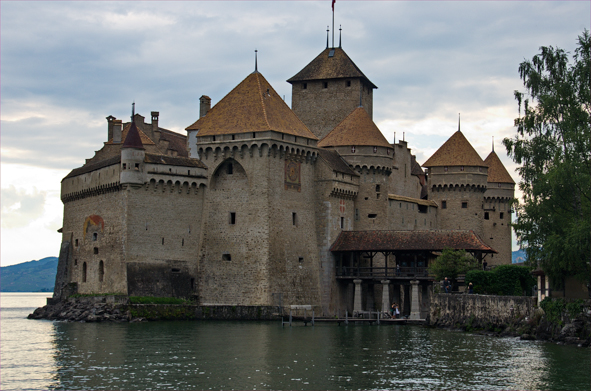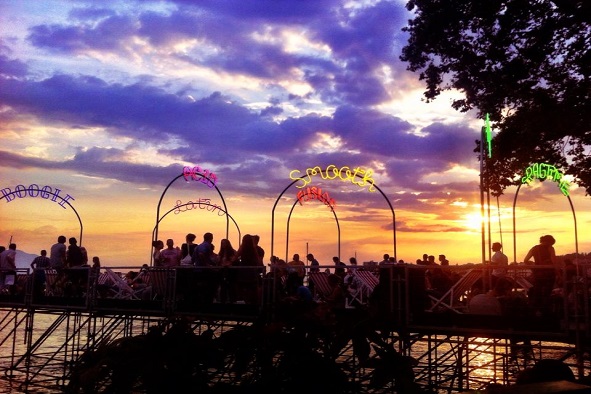Curving along the seductive shores of Lake Geneva, Montreux allures affluent visitors all year round. Whether dining in lavish restaurants, shopping for designer gear or staying at high-end hotels, this side of the glistening Swiss Riviera fits the upscale bill. Yet this beautiful city is not just for the well-to-do; an exhilarating music festival, fairy-tale castle and stunning alpine backdrop offers affordable options too.
No amount of Google image searches have prepared me for my first glimpse of Switzerland’s fairy-tale castle. Towering beige walls shoot up from Lake Geneva’s shimmering sapphire-coloured water. Several brown turret roofs slant like the pine green mountains shooting up from behind. I feel as though I’m sailing toward a set from Game of Thrones.
Mouth open, I shuffle across the wood-panel decking to a young sailor in a white shirt and navy blue cap. I point to the castle and mumble: “Is that….”
“Château de Chillon. Oui, monsieur!”
Suddenly the toot of the steam whistle pierces the warm, crisp air. The huge pistons thundering in the engine room ease up as the 100-year-old paddle steamer slows to a drift.
I’m on my mid-summer sojourn to Switzerland, attempting to discover whether I can enjoy a day out in one of its stylish cities without having to peddle my life’s belongings. Montreux, set on the banks of Lake Geneva (also known as Lac Léman) in the country’s west, oozes class – expensive class. Its boutique shops sparkle with diamonds and designer gear. Its pristine hotels, many built in the late 19th century Belle Époque (beautiful era), exude expense and make my wallet quiver. Some houses sell for upwards of $28 million and the winding roads, fixed onto the mountains, flow with Ferraris and fur coats.
Undeterred, I’ve chugged from neighbouring Lausanne on the Suisse steam boat ($44 return) and am ready to transport myself into medieval times at one of Switzerland’s iconic castles. And to help: an English audio guide I’ve downloaded for $3 (in addition to the $12 entrance fee).
Château de Chillon dates back almost 1,000 years and, although parts have been touched up and rebuilt, the original structure remains. The vertical-walled fortress stands on a rocky island close to the shore. From the 12th to 16th century the Courts of Savoy owned the castle, using it to control the waters, part of the passage through the Alps to Italy. It was also a macabre prison where torture and murder often occurred.
Feeling the chill of anticipation, I wander along the cobblestone courtyard with my British-accented audio guide. I scramble up tight, dark staircases and descend down into the crypt with its 11th century altar. Rubble and towering pillars adorn a vast underground hall wherein prisoners were held during the 16th century. A small plaque commemorating Lord Byron is etched onto the flaking wall. During his visit in 1816, the English writer was so taken by the story of François Bonivard, a prisoner for about four years here from 1530, he crafted a sonnet and the atmospheric ‘The Prisoner of Chillon’ poem:
There are seven pillars of Gothic mould,
In Chillon’s dungeons deep and old,
There are seven columns, massy and grey,
Dim with a dull imprison’d ray,
Feel the jazz beat
After visiting the dining hall, weapons room (and posing with a medieval sword), I slide my shades on and head to Montreux. A stunning two-mile promenade winds along the shoreline of Lake Geneva.
The Swiss Alps tower above my right shoulder. The mountain’s tree-laden surface cradles a winding road – surely one of the most scenic drives in Europe. Down below on the pebble beach, a man and woman in skimpy swimwear caress one another with sunscreen. The lake’s slopping waves gain force when a motorboat whizzes past; the trailing jet skier doing exceptionally well to carve looping turns without tumbling off. Switzerland might wane heavy on the purse strings, but the views on offer are frequently a rich enough recompense.
A few sharp high-pitched parps from a trumpet, before a deep horn ripples over the lake. A woman’s soulful voice drifts past to signal my arrival at the Montreux Jazz Festival.
While the Swiss might be synonymous with a hard-work ethic, diligence, and, of course, punctuality, the Montreux Jazz is a cacophony of tunes, booze and partying – with a diligent emphasis on ignoring the clock. Lasting for two weeks at the beginning of July, this fusion of international and local music trails only Canada’s Montreal as the biggest jazz festival in the world. Live acts spanning from Blues through Latin reverberate the normally sedate shoreline. Hordes of elegantly dressed locals bounce along gobbling Thai green curries and dishes of paella while sipping glasses of rosé wine.
From mid-afternoon to the early morning hours, groups of friends strip down to their briefs, gallop along the jetty and launch themselves into the cool lake. All under the watchful eye of the Freddie Mercury statue. Such scandalous behaviour would no doubt draw a huge smile and a fist pump from the iconic singer, who settled here towards the end of his life.
Although seeing well-known acts requires tickets, other parts of the jazz festival are free to enter. Locals bring their own picnics with bottles of wine and enjoy the live music sat on the grassy hill in front of the main outdoor stage. No need to re-mortgage the house just yet then.
April through October sees the flea market sprawl along the lakeside as bargain hunters pick up inexpensive trinkets. A ten-minute walk past the train station lies the Old Town. Here, for the few people that visit, is an opportunity to wander the charming cobbled road of Rue du Marche. The panoramic views of rolling vineyards and the French Alps make the steep(ish) climb worthwhile. The coffee shops that line the zigzagging streets and courtyards can be pricey, so people often lunch on the benches close to Saint Vincent’s church.
Sublime Swiss Treats
Of course, those wishing to tip the scales of expense can do so with ease. Stretching round to Vevey, the Swiss Riviera hosts five Michelin-starred restaurants and the exquisite Le Pont de Brent – a two-star treat located a few miles from Montreux. The menu mixes traditional Swiss cuisine with modern touches such as morels stuffed with foie gras.
If you’re keen for a coffee and a Swiss chocolate-infused dessert, then Zurcher serves up the finest. Set on the high street, this 1879-established café permanently throbs with diners. The outdoor tables, in particular, are highly sought after; locals cling to them as they would the final life rafts at sea. Inside, rounded booths are covered with flowered felt and lavish chandeliers provide the mood lighting. Rows of intricate truffles glisten in the glass dessert counter while ice-cream bombs and sorbets sooth the summer hunger. For me, an $8 orange juice quenches my thirst before I hit the road.
Prior to my Swiss sojourn, I’d heard about Montreux’s expensive side. I’d read about a city which has inspired writers like Lord Byron and Ernest Hemingway, and whose “peace and serenity” had enchanted Freddie Mercury. Yet, today I find a new side to Montreux. A side which, for a couple of weeks a year at least, encourages carefree fun alongside a bewitching medieval history.

